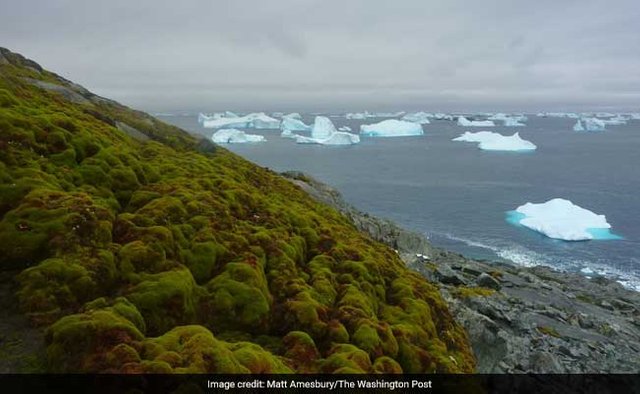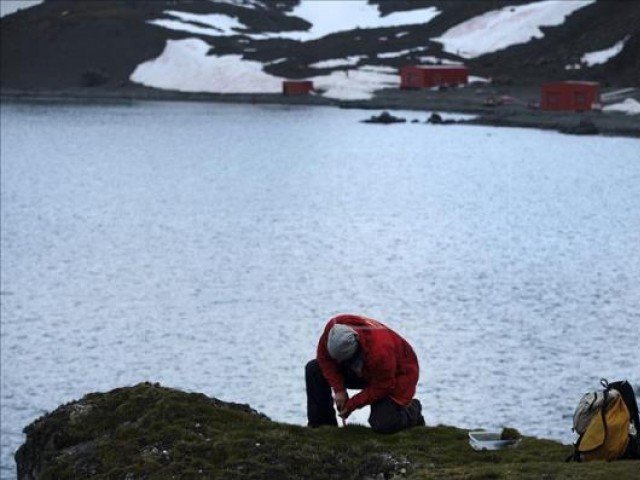
A decade ago, a thick layer of ice covered Collins Glacier on King George Island, Antarctica. Now, the rocky landscape can be seen with the naked eye in this victimized and laboratory area for climate change.
"I had a chance to come here for 15 years. Throughout human life, we can see the changes brought about by climate change, "said Marcelo Leppe, Director of Chilean Antartic Institute (INACH).
"Currently, researchers can see the stones we never saw 5-10 years ago. It is a direct proof of the glacier's shrinking and the loss of mass, "he added.
However, as these melting glaciers worried about the scientific world, the presence of Antarctica plants that proved resilient to extreme conditions provided hope for the warming planet.
Chile is one of 20 countries that have a scientific center on the cold continent. In the complex Professor Julio Escudero - Chile's Antarctic research center - dozens of researchers sought to measure the effects of climate change on flora and fauna.
"We need to measure changes to predict what will happen in the future," Leppe said.
The bloom of algae
Measurements made last year by Chilean scientists at Doumer Island, Antarctica, show that water temperatures rise by 2.5 degrees Celsius (normal temperatures range from 0 to 1.5 degrees Celsius). And at a depth of 40 meters, the temperature remains at 2 degrees celsius.
The warm water has attracted species previously unseen in Antarctica. For example, spider crabs are usually found in southern Chile.
In addition, there is a 'explosion' of green algae that is important for local ecosystems, especially for crustaceans.
"Although they are very small, algae and micro algae are essential for balancing the food chain," explains Nelson Valdivia, professor at Austral University of Chile.
"They supply nutrients to other ecosystems. We know that the number of species in the same ecosystem is an important factor in maintaining good health, "he added.
However, in the long run, the blooming of these algae can disrupt the ecological balance.
The researchers are concerned, species that have not been known to be lost before they find it. The researchers are also afraid of warmer temperatures in the other hemisphere.
Based on NASA monitoring from 2002 to 2016, it is known that Antarctica lost 125 gigatons of ice per year. Cause sea water rise 0.35 millimeters per year worldwide.
Antarctica stores 62 percent of water reserves, so melting there can be fatal. One of them reduces the salt content of sea water that is harmful to ocean species.
Adaptable plants
After all, this 'white continent' holds the key to the life of plants and animals that can adapt to temperature changes.
Antarctica plants - which are resistant to ultraviolet radiation and extreme conditions - have used biotechnology to create antioxidants, natural sugars, and protective lotions from sunlight.
In a miniature greenhouse, Marisol Pizarro, a biotechnology scientist from the University of Santiago, studied how Antarctic plants react to artificial temperatures that are increased by one to 2 degrees Celsius.
The results show, the moss can adapt well to changes in temperature - a benefit that might help other vegetation in the future.
Antarctica being one of the Earth's fastest-warming regions, forcing researchers to work faster against time. Chilean scientists in Antarctica do about 100 projects. Starting from the penguin's genetic observations, how the activity of the Sun affects the Polar environment, to compare local molluscs to those in South America.
Reference :
- https://phys.org/news/2018-03-antarctica-laboratory-climate.html
- http://www.taipeitimes.com/News/world/archives/2018/03/02/2003688547
- https://www.ndtv.com/world-news/antarctica-a-laboratory-for-climate-change-1818627
- http://www.france24.com/en/20180301-antarctica-laboratory-climate-change



Interesting post.
There is a lot of research that needs to be done. Although the decline in ice is generally a horrible thing for our environment the fact that bare rock becomes more and more exposed makes the geologist in me wonder what amazing scientific knowledge we will be able to gain from that.
Downvoting a post can decrease pending rewards and make it less visible. Common reasons:
Submit
This post has received a 2.91 % upvote from @booster thanks to: @alf4t1h.
Downvoting a post can decrease pending rewards and make it less visible. Common reasons:
Submit
Congratulations! This post has been upvoted from the communal account, @minnowsupport, by alf4t1h from the Minnow Support Project. It's a witness project run by aggroed, ausbitbank, teamsteem, theprophet0, someguy123, neoxian, followbtcnews, and netuoso. The goal is to help Steemit grow by supporting Minnows. Please find us at the Peace, Abundance, and Liberty Network (PALnet) Discord Channel. It's a completely public and open space to all members of the Steemit community who voluntarily choose to be there.
If you would like to delegate to the Minnow Support Project you can do so by clicking on the following links: 50SP, 100SP, 250SP, 500SP, 1000SP, 5000SP.
Be sure to leave at least 50SP undelegated on your account.
Downvoting a post can decrease pending rewards and make it less visible. Common reasons:
Submit